Kuzuryū (九頭龍, nine-headed dragon ), or Kuzuryūshin (九頭龍神, nine-headed dragon god) is a deity that appears in folklore and legends of various parts of Japan, including, for example, Hakone (Kanagawa), Nagano Prefecture and Fukui Prefecture. In many cases, the Kuzuryū is associated with water.
During the Nara period, a legend arose that the Nine-headed Dragon had settled in Lake Ashi in Hakone, and that it demanded a sacrifice. To appease the dragon, the villagers agreed to select a house by shooting a white-feathered arrow and seeing where it landed, then sacrificing the daughter of the house. A priest named Mankan (Japanese : 万巻上人) cursed the dragon, and is said to have chained it to the Upside-down Cedar (an underwater rock formation). As a result of this legend, the dragon came to be worshipped as Kuzuryū Daimyōjin (九頭竜大明神, "Great God Nine-Headed Dragon). The expression "send up a white-feathered arrow" has come to mean "choose by lot."
The legend continues, saying Mankan saw the dragon reform and change into a Dragon King. He then built a shrine to the dragon. After this the customary offering to the dragon changed from human sacrifice to steamed rice with red beans.
Kuzuryū is said to have appeared in response to the echoing sound of a rock door to a cave torn off by another god, and flung down to earth. The thrown door became Mount Togakushi, and Kuzuryū became a nearby mountain of the same name. At the foot of Mount Togakushi resides Togakushi Shrine, where a small shrine dedicated to the Kuzuryū can be found.
Kuzuryū's origins can be traced to the Hindu deities Vāsuki and Śeṣa, Nāgarajas who guard Mount Meru. According to Hindu myth, Śeṣa was one of one thousand nāga offspring of Kaśyapa and Kadrū. [1] His appearance is that of a giant snake with one thousand heads. The earrings, crown, and corolla attached to each one of one thousand heads depict are decorated with swastikas.
When Buddhism was introduced to China, Vāsuki was recognized as one of the Eight Great Nāga Kings. In Japan, due to the influence of Shintō on Buddhism, Vāsuki became a guardian deity in both religions. The Eight Nāga Kings became influential in the esoteric tradition, which has a strong focus on obtaining worldly benefits. This was reflected in Kuzuryū's role as a rainmaker deity. Kuzuryū is sometimes referred to as Kuzuryū Gongen, which refers to his identification with Vāsuki.
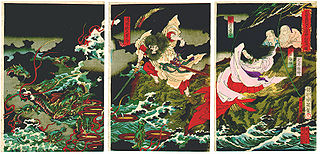
Yamata no Orochi, or simply Orochi (大蛇), is a legendary eight-headed and eight-tailed Japanese dragon/serpent.

The Dragon King, also known as the Dragon God, is a Chinese water and weather god. He is regarded as the dispenser of rain, commanding over all bodies of water. He is the collective personification of the ancient concept of the lóng in Chinese culture.

Tianlong is a flying dragon in Chinese mythology, a star in Chinese astrology, and a proper name.

The Nagas are a divine, or semi-divine, race of half-human, half-serpent beings that reside in the netherworld (Patala), and can occasionally take human or part-human form, or are so depicted in art. A female naga is called a Nagi, or a Nagini. According to legend, they are the children of the sage Kashyapa and Kadru. Rituals devoted to these supernatural beings have been taking place throughout South Asia for at least 2,000 years. They are principally depicted in three forms: as entirely human with snakes on the heads and necks, as common serpents, or as half-human, half-snake beings in Hinduism, Buddhism, and Jainism.

Vasuki is the second king of the nagas in Hinduism. He is described as having a gem called Nagamani on his head. Shesha, the first king of the nagas and the bed on which Vishnu rests, is his elder brother, and Manasa, another naga goddess, is his sister. In Hindu iconography, he is generally depicted coiling around the neck of Shiva, who is believed to have blessed and worn him as an ornament.

Japanese dragons are diverse legendary creatures in Japanese mythology and folklore. Japanese dragon myths amalgamate native legends with imported stories about dragons from China, Korea and the Indian subcontinent. The style and appearance of the dragon was heavily influenced by the Chinese dragon, especially the three-clawed long (龍) dragons which were introduced in Japan from China in ancient times. Like these other East Asian dragons, most Japanese ones are water deities or kami associated with rainfall and bodies of water, and are typically depicted as large, wingless, serpentine creatures with clawed feet.

Nagaraja is a title used to refer to the nagas, the serpent-like figures that appear in Indian religions. It refers to the kings of the various races of the nāga, the divine or semi-divine, half-human, half-serpent beings that reside in the netherworld (Patala), and can occasionally take human form. Rituals devoted to these supernatural beings have been taking place throughout South Asia for at least two thousand years.

The Togakushi Shrine is a Shinto shrine in Togakushi, Nagano (city), Nagano Prefecture, Japan. The shrine is at the base of Mount Togakushi in Myōkō-Togakushi Renzan National Park. Togakushi Shrine consists of five shrines, known as the lower, middle, and upper shrine area, each area about 2 km apart.

Zennyo Ryūō is a rain-god dragon in Japanese mythology. According to Japanese Buddhist tradition, the priest Kūkai made Zennyo Ryūō appear in 824 AD during a famous rainmaking contest at the Kyoto Imperial Palace.
Watatsumi[watatsɯmi], also pronounced Wadatsumi, is a legendary kami, Japanese dragon and tutelary water deity in Japanese mythology. Ōwatatsumi no kami is believed to be another name for the sea deity Ryūjin and also for the Watatsumi Sanjin, which rule the upper, middle and lower seas respectively and were created when Izanagi was washing himself of the dragons blood when he returned from Yomi, "the underworld".
Okami in the Kojiki, or in the Nihon Shoki: Kuraokami (闇龗) or Okami (龗), is a legendary Japanese dragon and Shinto deity of rain and snow. In Japanese mythology, the sibling progenitors Izanagi and Izanami gave birth to the islands and gods of Japan. After Izanami died from burns during the childbirth of the fire deity Kagu-tsuchi, Izanagi was enraged and killed his son. Kagutsuchi's blood or body, according to differing versions of the legend, created several other deities, including Kuraokami.
This is the glossary of Shinto, including major terms on the subject. Words followed by an asterisk (*) are illustrated by an image in one of the photo galleries.

The Hakone Shrine is a Japanese Shinto shrine on the shores of Lake Ashi in the town of Hakone in the Ashigarashimo District of Kanagawa Prefecture. It is also known as the Hakone Gongen (箱根権現).
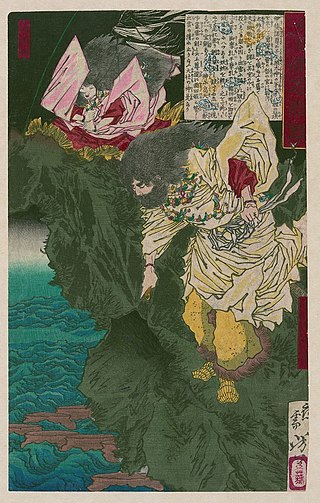
Kushinadahime (クシナダヒメ), also known as Kushiinadahime (クシイナダヒメ) or Inadahime among other names, is a goddess (kami) in Japanese mythology and the Shinto faith. According to these traditions, she is one of the wives of the god Susanoo, who rescued her from the monster Yamata no Orochi. As Susanoo's wife, she is a central deity of the Gion cult and worshipped at Yasaka Shrine.
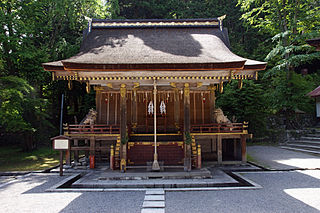
Sanno Shinto was a syncretic shinto group with elements from Tendai buddhism. It began in the early Edo Period. It no longer exists
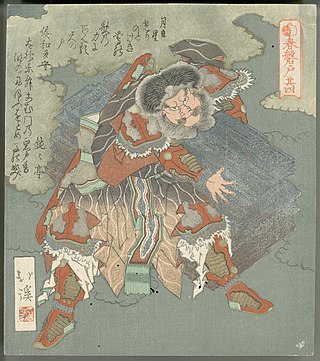
Ame-no-tajikarao (アメノタヂカラオ) is a Japanese deity (kami) who appears in Japanese mythology. Ame-no-tajikarao is written as 天手力男神 in Kojiki, and 天手力雄神 in Nihon Shoki. Tajikarao's name means heaven hand power.

Takeminakata (タケミナカタ), also known as Minakatatomi or Takeminakatatomi, is a kami in Japanese mythology. Also known as Suwa Myōjin (諏訪明神) or Suwa Daimyōjin (諏訪大明神) after Suwa Grand Shrine in Nagano Prefecture in which he is enshrined alongside his consort Yasakatome, Takeminakata is historically worshiped as a god of wind, water and agriculture, as well as a patron of hunting and warfare, in which capacity he enjoyed a particularly fervent cult from various samurai clans during the medieval period such as the Hōjō or the Takeda. Takeminakata was also held to be the mythical ancestor of certain families who once served at the shrine as priests, foremost among them being the Suwa clan, the high priests of the Upper Shrine of Suwa who were also revered as living vessels of the god.
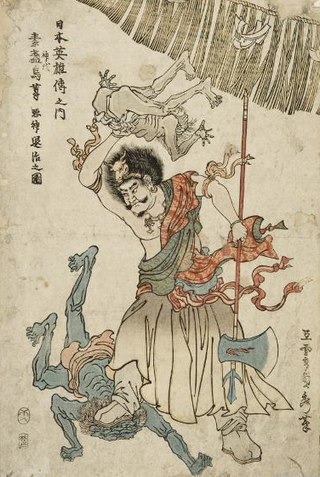
Gozu Tennō is a syncretic Japanese deity of disease and healing. Originally imported to Japan from mainland Asia, he was regarded since the Heian period both as a causer of and protector against epidemics and eventually became amalgamated with the native kami Susanoo during the medieval and early modern periods. During the Meiji period, when the government mandated the separation of Shinto and Buddhism, Shinto shrines dedicated to Gozu Tennō of the Gion cult tradition such as Yasaka Shrine in the Gion district of Kyoto or Tsushima Shrine in Tsushima, Aichi Prefecture officially reidentified their enshrined deity as Susanoo.

Mount Togakushi is located in the former village of Togakushi, now located within the city of Nagano, Nagano, Japan. The mountain is 1904 meters (6247 ft) high. Mount Togakushi has traditionally been included in the Five Mountains of Northern Shinshu that includes Mount Myōkō, Mount Kurohime, Mount Iizuna and Mount Madarao .